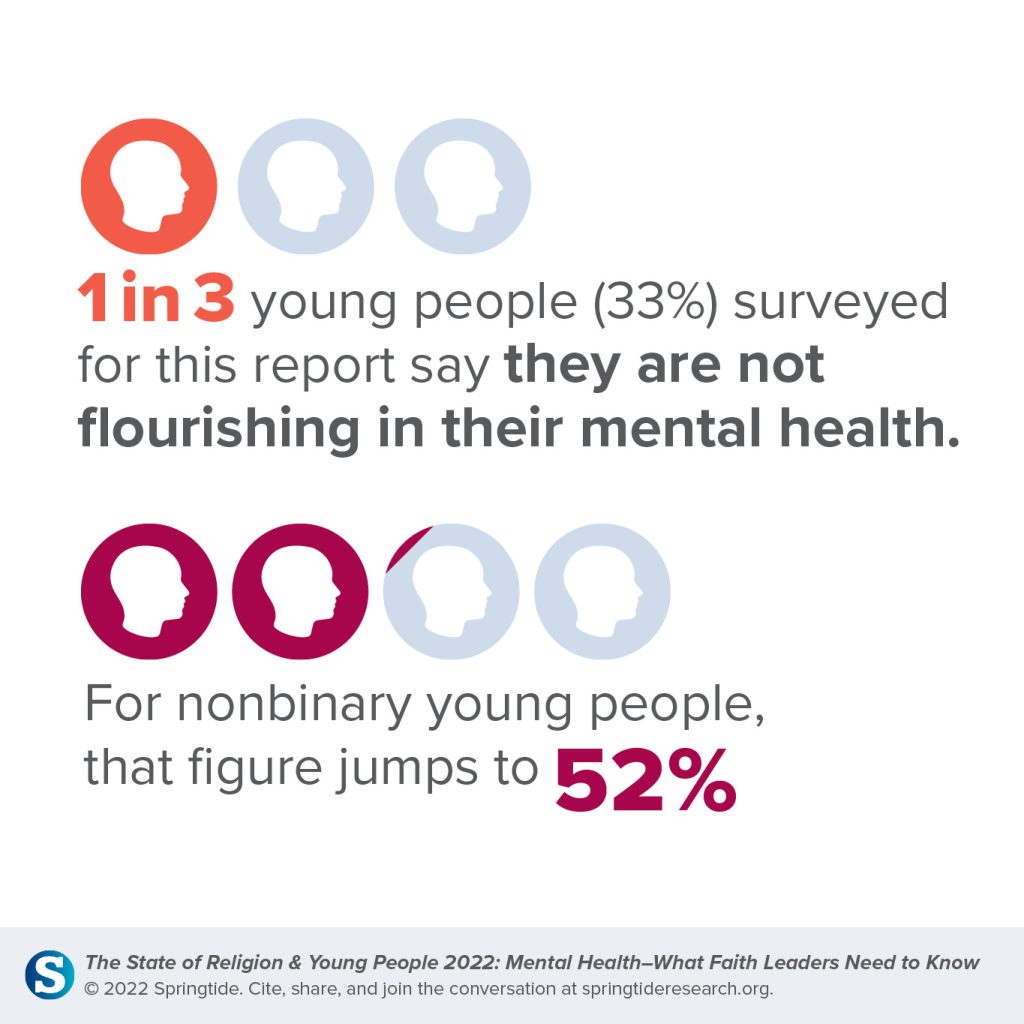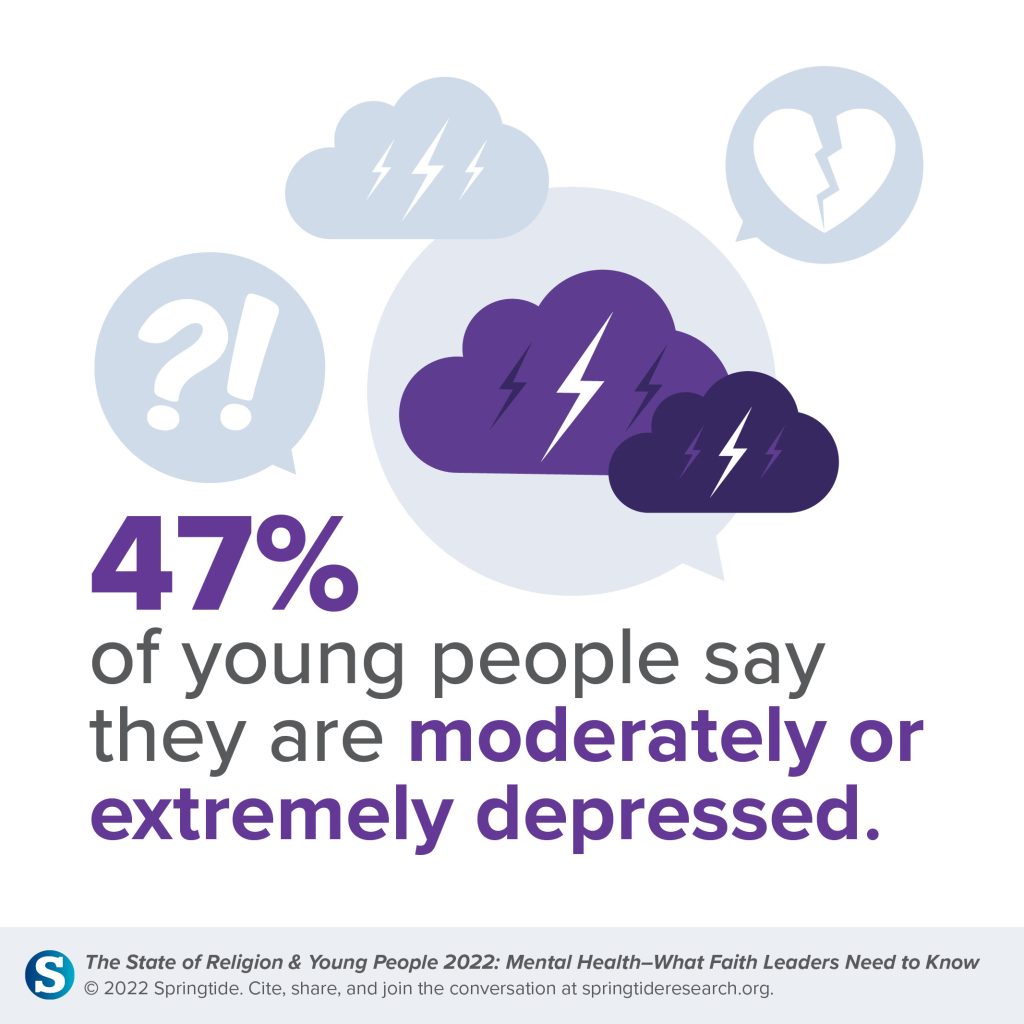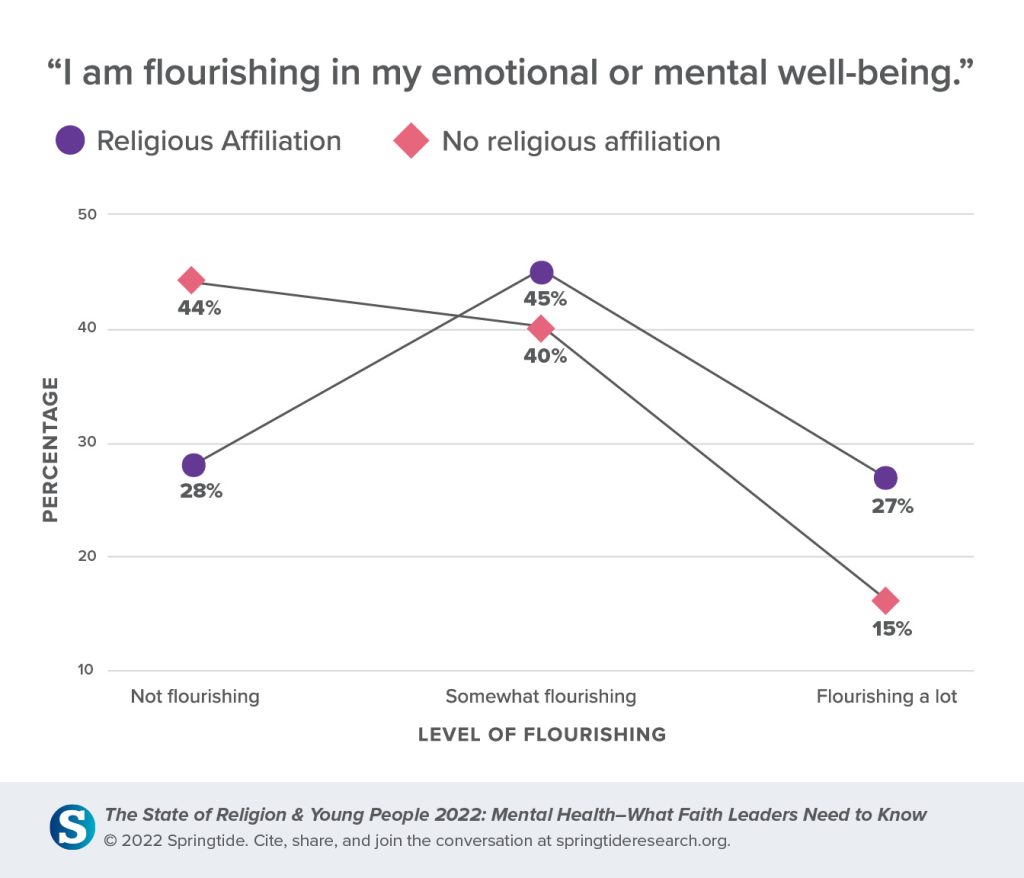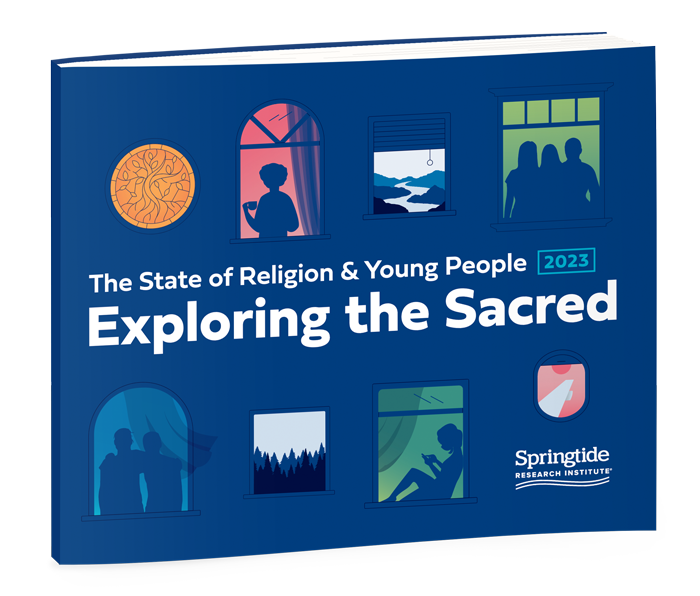Gen Z’s Mental Health: Everything You Need to Know
Mental-health issues among Gen Z are unlike those of previous generations of young people. Health care company Cigna released a study on loneliness in 2018 showing (perhaps for the first time) that people aged 18–22 were lonelier than those over 72. A number of organizations, including the CDC, released data documenting this generation’s struggles with anxiety, depression, and suicide even before the pandemic. Most recently, the US surgeon general has named loneliness a “public health crisis” for all Americans, which supports previous research as well as data collected during the COVID-19 pandemic showing the toll it takes on young people’s mental health.
Springtide data confirm claims made by governmental entities and other groups that young people face a mental-health crisis. In Springtide’s 2020 study Belonging: Reconnecting America’s Loneliest Generation, where more than 1,000 young people ages 13–25 were surveyed and/or interviewed, one in three young people said they feel completely alone most of the time. Forty-five percent said they feel that no one understands them. Forty percent said they have no one to talk to and feel left out. Two-thirds of young people report that they have three or fewer meaningful social interactions a day. Fifty-eight percent reported feeling stressed and overwhelmed.
When we asked young people specifically about their experiences during the COVID-19 pandemic, they told us that their biggest challenge was their mental health—not the fear of getting sick, which was third on the list. Being alone came in second. For many young people, the mental challenges outweighed the physical realities of COVID, and these challenges still have an effect today.
Data on Mental Health & Gen Z
- A third of young people say they are not flourishing in their mental and emotional health.
- Nearly 1 in 4 (24%) say they are currently or have been medicated or hospitalized for mental-health issues.
- Nearly half of young people (47%) report being moderately or extremely depressed.
- Over half of young people say they are moderately or extremely anxious (55%) or moderately or extremely stressed (57%).
- Forty-five percent report being moderately or extremely lonely.
- Almost two-thirds of young people (61%) agree with the statement “The adults in my life don’t truly know how much I am struggling with my mental health.”




Mental-health issues among Gen Z are unlike those of previous generations of young people. Health care company Cigna released a study on loneliness in 2018 showing (perhaps for the first time) that people aged 18–22 were lonelier than those over 72. A number of organizations, including the CDC, released data documenting this generation’s struggles with anxiety, depression, and suicide even before the pandemic. Most recently, the US surgeon general has named loneliness a “public health crisis” for all Americans, which supports previous research as well as data collected during the COVID-19 pandemic showing the toll it takes on young people’s mental health.
Springtide data confirm claims made by governmental entities and other groups that young people face a mental-health crisis. In Springtide’s 2020 study Belonging: Reconnecting America’s Loneliest Generation, where more than 1,000 young people ages 13–25 were surveyed and/or interviewed, one in three young people said they feel completely alone most of the time. Forty-five percent said they feel that no one understands them. Forty percent said they have no one to talk to and feel left out. Two-thirds of young people report that they have three or fewer meaningful social interactions a day. Fifty-eight percent reported feeling stressed and overwhelmed.
When we asked young people specifically about their experiences during the COVID-19 pandemic, they told us that their biggest challenge was their mental health—not the fear of getting sick, which was third on the list. Being alone came in second. For many young people, the mental challenges outweighed the physical realities of COVID, and these challenges still have an effect today.
Data on BIPOC Gen Z & Mental Health
Gen Z is the most diverse generation to date—and our survey and interview data reflect unique experiences, desires, and needs for Black, Indigenous, People of Color (BIPOC). For young BIPOC, the mental-health crisis experienced by this generation is intensified by racial prejudice and discrimination. Despite those challenges, the young BIPOC we surveyed are actually flourishing mentally and emotionally at rates comparable to their White peers. They report similar levels of anxiety and depression, as well as similar rates of life satisfaction, confidence, and joy.




When compared with their White peers’ self-reported rates of flourishing, young BIPOC say they are flourishing at slightly higher rates than their White peers. But while young BIPOC and their White peers report similar rates of depression and anxiety, young BIPOC are less likely than their White peers to have received mental-health treatment.
For young BIPOC, data show that having a healthy ethnic-racial identity (ERI) is a great source of joy and meaning in their lives. An ERI is a social identity—part of a person’s self-understanding that comes from their membership in social groups or categories. Having a healthy ERI means maintaining a positive view of oneself and recognizing their worth as a person who belongs to a particular social group. Research shows that people with positive social identities are generally more resilient in the face of adversity, are better equipped to cope with stress, and are more likely to pursue and achieve their goals. For young BIPOC in particular, research confirms that ethnic and racial pride significantly offset the negative impact of racial discrimination on their mental health.
How Religion and Spirituality Support Gen Z's Mental Health
Research from the social sciences has long shown a relationship between being religious or spiritual and well-being. Springtide data support that association and show that many young people recognize the value of religion and spirituality for mental wellness.
- Fifty-five percent of those we surveyed agree that their religious or spiritual life matters for their mental health.
- Fifty-seven percent agree that their religious or spiritual practices matter for their mental health.
- Young people who say they are religious are more likely to agree or strongly agree that they are in good physical and emotional condition.
- Religious young people say they are flourishing more than their nonreligious counterparts.
- Praying and attending religious services are correlated with mental and emotional flourishing.
- Believing in a higher power is distinct from feeling connected to it, but both strong belief and feelings of connection correlate with greater self-reported flourishing in one’s mental and emotional health. This aligns with prior social science research showing that those who report religious or spiritual belief and practice tend to be happier than those who don’t.

Young people may not visit a house of worship regularly, but they do report engaging in religious and spiritual practices— and these can make a difference in how they feel. Our data show that nearly two-thirds of young people are wholly or largely absent from religious services. Yet, 47% of the young people we surveyed say they engage in art as a spiritual practice at least weekly, and 44 % say being in nature serves as a spiritual practice for them at least weekly. Seventy-four percent of young people who say they pray daily also say they’re “flourishing a lot.”
Creating Spaces for Gen Z That Are Mental-Health Friendly
The national conversation about mental health has largely focused on the individual and the psychological—that is, what one person can be doing differently to improve their own mental health. While this is important, considering the collective is equally vital. What can organizations and groups be doing to better support the mental health of their young people? Our data show that organizations that create connection, foster alignment between tools and expectations, and help young people discover a sense of purpose are most likely to succeed at promoting the mental health and flourishing of young people. Below are suggestions for how adults can act in the various organizations.
How Faith Communities Can Support Gen Z’s Mental Health
Prioritize connection. Data from our State of Religion and Young People 2022: Mental Health report show that Gen Z’s religious and spiritual lives help them feel connected—and being connected improves their mental health. Some young people benefit just from the sense of community faith traditions can offer, while others fare better because of the meaningful relationships they build. Our data show that connection is created by fostering a sense of belonging. As a young person moves from initially joining an organization or group to experiencing real belonging within it, three distinct feelings surface: feeling noticed, feeling named, and feeling known. We refer to this pattern of moving from noticed to named to known as the Belongingness Process.
Set expectations . . . and offer the tools to achieve them. In our 2022 report, Gen Zers were clear that if religion is presented like a set of expectations that seem difficult to meet rather than as a way to help them navigate the ups and downs of life, it can feel toxic. Faith leaders should have expectations for the young people in their care— and they should offer ways and resources to make those expectations feel attainable. If young people understand what’s expected of them but still have a sense of agency in how that aligns with their values and identities, their mental wellness is enhanced.
Help facilitate finding purpose. We define purpose as a sense of connection with something or someone bigger than oneself, and that sense can take a variety of forms depending on the tradition or the participant in it. Having this sense of purpose matters to Gen Z. For young people, this might be a hobby they’re passionate about, a community they’re involved with, a spiritual practice that grounds them, a belief in a divine source, or something else. Though few young people turn to traditional institutional religion as a one-stop shop for their purpose-seeking, several of the young people we surveyed say that their faith community plays a pivotal role in that overall process. Religious and spiritual communities are an ideal domain for conversations about what it means to align with something greater, and religious and spiritual leaders are an excellent fit to help young people navigate the path to purpose.
How Educators Can Support Gen Z’s Mental Health
Help students feel connected to the school community. The Belongingness process applies in any group setting, and it is especially effective in schools. Educators can help students feel noticed, named, and known in a variety of ways, including calling students by their preferred names and pronouns to helping to facilitate peer-to-peer connections. Also, adults can look for students who may be less likely to feel connected to the school community—transfer students, those who don’t have resources to participate in extracurricular activities, students whose families can’t access school communications because of language barriers or technological gaps, or those who are in external activities not recognized by the school. Locate those students and see what small steps one could take to bring them into the fold.
Make sure students are prepared to succeed. Expectations exist around school performance, and educators can help position students for success by ensuring that students understand the expectations and have the tools and resources to meet them. While a majority of students we surveyed said they feel they have the tools and resources for success, others say that having expectations that felt unattainable or overwhelming negatively impact their mental health. Educators can note the gaps between set expectations and students’ ability to achieve them, and advocate for changes that help create better alignment. In addition, educators can locate the pockets of students who may feel that the school doesn’t help them to succeed and ask them why they feel this way. It could be a result of unclear expectations, poor tools, or that the tools available don’t seem designed to help them.
Create mission. Sociologists have shown that groups that prioritize the pursuit of meaning and purpose, both as a group and among individuals, have positive effects on the mental wellness of their members. When this work is done on the individual level, it might be called purpose. When an organization has a sense of purpose—the kind that models and encourages individual exploration—it’s called mission. Educators can help implement this by reframing everyday tasks through accountability (both a connection to something bigger and a sense of responsibility toward that bigger thing), autonomy (finding ways to offer students choice), and authenticity (noticing what students are good at and encouraging them in those directions).
How Parents Can Support Gen Z’s Mental Health
Ensure that young people feel like they’re a part of the family. In many ways, families function like organizations, and focusing on belonging at home is just as crucial as in any other environment. Our data show that some young people don’t feel like they belong in their own families and that they can’t be their authentic selves with them. No matter how tight-knit your family is, consider taking additional steps to ensure that your young people feel seen and included by spending quality time together and taking notice when something seems to be affecting them.
Make sure there’s agreement on expectations. Young people flourish when they understand the expectations set for them and have the tools to meet them. For parents, this means being present and available. Adults who listen, care, live with integrity, are transparent, and use their expertise are able to build trust with young people. This enables them to have meaningful exchanges in which there can be honest conversations about the expectations young people feel are being placed on them, and whether those are reasonable and attainable.
Look for opportunities to help young people find purpose. Discovering purpose can boost young people’s mental health, but sometimes the search for that purpose can be disorienting and frustrating. To sidestep any negative impacts on mental health, parents can encourage the search and help young people weather the stress by offering trusting and nonjudgmental support. In addition, parents can note their likes and interests and suggest activities that could help them make the connections that lead to purpose.
Easy Navigation
Mental-health issues among Gen Z are unlike those of previous generations of young people. Health care company Cigna released a study on loneliness in 2018 showing (perhaps for the first time) that people aged 18–22 were lonelier than those over 72. A number of organizations, including the CDC, released data documenting this generation’s struggles with anxiety, depression, and suicide even before the pandemic. Most recently, the US surgeon general has named loneliness a “public health crisis” for all Americans, which supports previous research as well as data collected during the COVID-19 pandemic showing the toll it takes on young people’s mental health.
Springtide data confirm claims made by governmental entities and other groups that young people face a mental-health crisis. In Springtide’s 2020 study Belonging: Reconnecting America’s Loneliest Generation, where more than 1,000 young people ages 13–25 were surveyed and/or interviewed, one in three young people said they feel completely alone most of the time. Forty-five percent said they feel that no one understands them. Forty percent said they have no one to talk to and feel left out. Two-thirds of young people report that they have three or fewer meaningful social interactions a day. Fifty-eight percent reported feeling stressed and overwhelmed.
When we asked young people specifically about their experiences during the COVID-19 pandemic, they told us that their biggest challenge was their mental health—not the fear of getting sick, which was third on the list. Being alone came in second. For many young people, the mental challenges outweighed the physical realities of COVID, and these challenges still have an effect today.
Springtide data on Mental Health & Gen Z
- A third of young people say they are not flourishing in their mental and emotional health.
- Nearly 1 in 4 (24%) say they are currently or have been medicated or hospitalized for mental-health issues.
- Nearly half of young people (47%) report being moderately or extremely depressed.
- Over half of young people say they are moderately or extremely anxious (55%) or moderately or extremely stressed (57%).
- Forty-five percent report being moderately or extremely lonely.
- Almost two-thirds of young people (61%) agree with the statement “The adults in my life don’t truly know how much I am struggling with my mental health.”
Mental-health issues among Gen Z are unlike those of previous generations of young people. Health care company Cigna released a study on loneliness in 2018 showing (perhaps for the first time) that people aged 18–22 were lonelier than those over 72. A number of organizations, including the CDC, released data documenting this generation’s struggles with anxiety, depression, and suicide even before the pandemic. Most recently, the US surgeon general has named loneliness a “public health crisis” for all Americans, which supports previous research as well as data collected during the COVID-19 pandemic showing the toll it takes on young people’s mental health.
Springtide data confirm claims made by governmental entities and other groups that young people face a mental-health crisis. In Springtide’s 2020 study Belonging: Reconnecting America’s Loneliest Generation, where more than 1,000 young people ages 13–25 were surveyed and/or interviewed, one in three young people said they feel completely alone most of the time. Forty-five percent said they feel that no one understands them. Forty percent said they have no one to talk to and feel left out. Two-thirds of young people report that they have three or fewer meaningful social interactions a day. Fifty-eight percent reported feeling stressed and overwhelmed.
When we asked young people specifically about their experiences during the COVID-19 pandemic, they told us that their biggest challenge was their mental health—not the fear of getting sick, which was third on the list. Being alone came in second. For many young people, the mental challenges outweighed the physical realities of COVID, and these challenges still have an effect today.
Springtide data on BIPOC Gen Z & Mental Health
Gen Z is the most diverse generation to date—and our survey and interview data reflect unique experiences, desires, and needs for Black, Indigenous, People of Color (BIPOC). For young BIPOC, the mental-health crisis experienced by this generation is intensified by racial prejudice and discrimination. Despite those challenges, the young BIPOC we surveyed are actually flourishing mentally and emotionally at rates comparable to their White peers. They report similar levels of anxiety and depression, as well as similar rates of life satisfaction, confidence, and joy.
When compared with their White peers’ self-reported rates of flourishing, young BIPOC say they are flourishing at slightly higher rates than their White peers. But while young BIPOC and their White peers report similar rates of depression and anxiety, young BIPOC are less likely than their White peers to have received mental-health treatment.
For young BIPOC, data show that having a healthy ethnic-racial identity (ERI) is a great source of joy and meaning in their lives. An ERI is a social identity—part of a person’s self-understanding that comes from their membership in social groups or categories. Having a healthy ERI means maintaining a positive view of oneself and recognizing their worth as a person who belongs to a particular social group. Research shows that people with positive social identities are generally more resilient in the face of adversity, are better equipped to cope with stress, and are more likely to pursue and achieve their goals. For young BIPOC in particular, research confirms that ethnic and racial pride significantly offset the negative impact of racial discrimination on their mental health.
How Religion and Spirituality Support Gen Z's Mental Health
Research from the social sciences has long shown a relationship between being religious or spiritual and well-being. Springtide data support that association and show that many young people recognize the value of religion and spirituality for mental wellness.
- Fifty-five percent of those we surveyed agree that their religious or spiritual life matters for their mental health.
- Fifty-seven percent agree that their religious or spiritual practices matter for their mental health.
- Young people who say they are religious are more likely to agree or strongly agree that they are in good physical and emotional condition.
- Religious young people say they are flourishing more than their nonreligious counterparts.
- Praying and attending religious services are correlated with mental and emotional flourishing.
- Believing in a higher power is distinct from feeling connected to it, but both strong belief and feelings of connection correlate with greater self-reported flourishing in one’s mental and emotional health. This aligns with prior social science research showing that those who report religious or spiritual belief and practice tend to be happier than those who don’t.
Young people may not visit a house of worship regularly, but they do report engaging in religious and spiritual practices— and these can make a difference in how they feel. Our data show that nearly two-thirds of young people are wholly or largely absent from religious services. Yet, 47% of the young people we surveyed say they engage in art as a spiritual practice at least weekly, and 44 % say being in nature serves as a spiritual practice for them at least weekly. Seventy-four percent of young people who say they pray daily also say they’re “flourishing a lot.”
Creating Spaces for Gen Z That Are Mental-Health Friendly
The national conversation about mental health has largely focused on the individual and the psychological—that is, what one person can be doing differently to improve their own mental health. While this is important, considering the collective is equally vital. What can organizations and groups be doing to better support the mental health of their young people? Our data show that organizations that create connection, foster alignment between tools and expectations, and help young people discover a sense of purpose are most likely to succeed at promoting the mental health and flourishing of young people. Below are suggestions for how adults can act in the various organizations.
How Faith Communities Can Support Gen Z’s Mental Health
Prioritize connection. Data from our State of Religion and Young People 2022: Mental Health report show that Gen Z’s religious and spiritual lives help them feel connected—and being connected improves their mental health. Some young people benefit just from the sense of community faith traditions can offer, while others fare better because of the meaningful relationships they build. Our data show that connection is created by fostering a sense of belonging. As a young person moves from initially joining an organization or group to experiencing real belonging within it, three distinct feelings surface: feeling noticed, feeling named, and feeling known. We refer to this pattern of moving from noticed to named to known as the Belongingness Process.
Set expectations . . . and offer the tools to achieve them. In our 2022 report, Gen Zers were clear that if religion is presented like a set of expectations that seem difficult to meet rather than as a way to help them navigate the ups and downs of life, it can feel toxic. Faith leaders should have expectations for the young people in their care— and they should offer ways and resources to make those expectations feel attainable. If young people understand what’s expected of them but still have a sense of agency in how that aligns with their values and identities, their mental wellness is enhanced.
Help facilitate finding purpose. We define purpose as a sense of connection with something or someone bigger than oneself, and that sense can take a variety of forms depending on the tradition or the participant in it. Having this sense of purpose matters to Gen Z. For young people, this might be a hobby they’re passionate about, a community they’re involved with, a spiritual practice that grounds them, a belief in a divine source, or something else. Though few young people turn to traditional institutional religion as a one-stop shop for their purpose-seeking, several of the young people we surveyed say that their faith community plays a pivotal role in that overall process. Religious and spiritual communities are an ideal domain for conversations about what it means to align with something greater, and religious and spiritual leaders are an excellent fit to help young people navigate the path to purpose.
How Educators Can Support Gen Z’s Mental Health
Help students feel connected to the school community. The Belongingness process applies in any group setting, and it is especially effective in schools. Educators can help students feel noticed, named, and known in a variety of ways, including calling students by their preferred names and pronouns to helping to facilitate peer-to-peer connections. Also, adults can look for students who may be less likely to feel connected to the school community—transfer students, those who don’t have resources to participate in extracurricular activities, students whose families can’t access school communications because of language barriers or technological gaps, or those who are in external activities not recognized by the school. Locate those students and see what small steps one could take to bring them into the fold.
Make sure students are prepared to succeed. Expectations exist around school performance, and educators can help position students for success by ensuring that students understand the expectations and have the tools and resources to meet them. While a majority of students we surveyed said they feel they have the tools and resources for success, others say that having expectations that felt unattainable or overwhelming negatively impact their mental health. Educators can note the gaps between set expectations and students’ ability to achieve them, and advocate for changes that help create better alignment. In addition, educators can locate the pockets of students who may feel that the school doesn’t help them to succeed and ask them why they feel this way. It could be a result of unclear expectations, poor tools, or that the tools available don’t seem designed to help them.
Create mission. Sociologists have shown that groups that prioritize the pursuit of meaning and purpose, both as a group and among individuals, have positive effects on the mental wellness of their members. When this work is done on the individual level, it might be called purpose. When an organization has a sense of purpose—the kind that models and encourages individual exploration—it’s called mission. Educators can help implement this by reframing everyday tasks through accountability (both a connection to something bigger and a sense of responsibility toward that bigger thing), autonomy (finding ways to offer students choice), and authenticity (noticing what students are good at and encouraging them in those directions).
How Parents Can Support Gen Z’s Mental Health
Ensure that young people feel like they’re a part of the family. In many ways, families function like organizations, and focusing on belonging at home is just as crucial as in any other environment. Our data show that some young people don’t feel like they belong in their own families and that they can’t be their authentic selves with them. No matter how tight-knit your family is, consider taking additional steps to ensure that your young people feel seen and included by spending quality time together and taking notice when something seems to be affecting them.
Make sure there’s agreement on expectations. Young people flourish when they understand the expectations set for them and have the tools to meet them. For parents, this means being present and available. Adults who listen, care, live with integrity, are transparent, and use their expertise are able to build trust with young people. This enables them to have meaningful exchanges in which there can be honest conversations about the expectations young people feel are being placed on them, and whether those are reasonable and attainable.
Look for opportunities to help young people find purpose. Discovering purpose can boost young people’s mental health, but sometimes the search for that purpose can be disorienting and frustrating. To sidestep any negative impacts on mental health, parents can encourage the search and help young people weather the stress by offering trusting and nonjudgmental support. In addition, parents can note their likes and interests and suggest activities that could help them make the connections that lead to purpose.
Easy Navigation
Find out how young people are finding the sacred. . . and how it impacts their mental health
The State of Religion & Young People 2023: Exploring the Sacred, uncovers how young people have been encountering and exploring concepts of sacredness and belonging in unexpected ways.
The State of Religion & Young People 2023: Exploring the Sacred, uncovers how young people have been encountering and exploring concepts of sacredness and belonging in unexpected ways.



